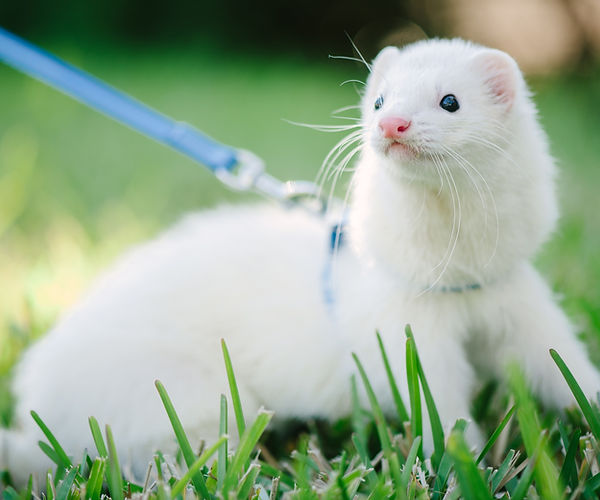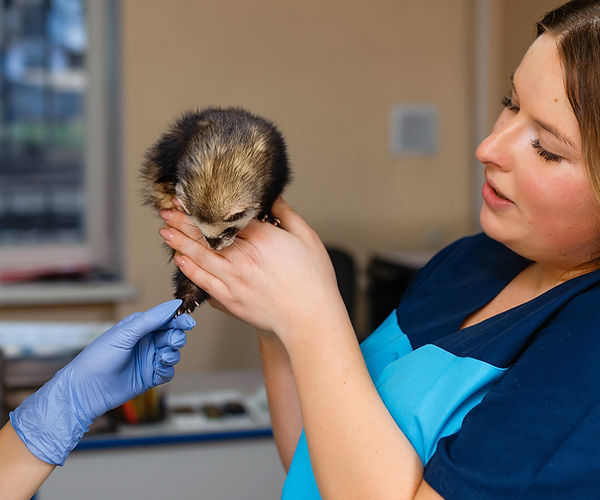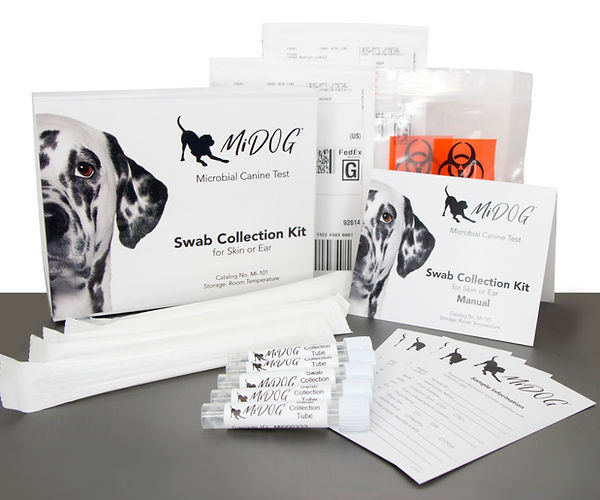
Ferrets are particularly prone to urinary tract infections.
In addition to their mischievous (but playful) nature and affinity for PVC pipes and socks, ferrets are identifiable by unique physiology that predisposes them to a variety of renal diseases pet owners need to be on the lookout for. If your ferret seems to be straining to urinate, it is worthwhile to take your furry friend to a ferret veterinarian since your ferret may have a condition called urolithiasis. Urolithiasis is painful and if left untreated can result in dangerous urogenital complications, and so early identification and intervention is beneficial.
What is Urolithiasis?
Urolithiasis is the most common nutritional disease in ferrets and is characterized by the presence of uroliths in the urinary tract [1]. Uroliths are made of stones, crystals, or calculi, with one of the most common components in the United States being magnesium ammonium phosphate (or struvite) [1]. Increasingly, cystine has become the most common composition of ferret calculus in the United States, with researchers attributing North American inbreeding as a potential cause for this spike [1].
Regardless, nutrition plays a large role in urolithiasis manifestation, as ferrets fed diets of poor quality dog or cat food contain high plant protein levels [2]. These high protein levels encourage crystal and stone formation by increasing the pH of your ferret’s urine. In contrast, ferrets fed high-quality, meat-based diets had more acidic urine [2]. One study found that 14% of the ferrets fed dog food had renal or cystic calculi [1]. It is worth noting that non-dietary causes of urolithiasis exist, such as urinary tract infections (UTIs) or physical injury to your ferret’s renal system, but these are less common [2]. Urease-producing microbial urinary infections are predominantly implicated with UTI-induced struvite formation [3].

The image above depicts a ferret being examined by a veterinarian.
Symptoms of Urolithiasis in Ferrets:
Urolithiasis presents most often in adult neutered males [1]. The condition is painful and causes inflammation of the urethra, bladder, and/or kidneys [3]. Moreover, this inflammation may leave the ferret susceptible to secondary bacterial infections. Presentation of urolithiasis can be more difficult in female ferrets, as affected jills may be asymptomatic or may exhibit symptoms intermittently [2]. Obstruction of the urethra is more common in males than females but does occur. Regardless of sex, urinary obstructions are life-threatening and need to be addressed by a veterinarian as soon as possible. Here are some common symptoms associated with ferret urolithiasis:
- Painful and strained urination
- Dribbling urine
- Strong odor in urine
- Bloody or cloudy urine
- Loss of appetite
- Weakness
- Vocalization when urinating
- Frequent genital licking
Treatment of Urolithiasis in Ferrets:
If you think your ferret may have urolithiasis, the best thing you can do is get a quick and accurate diagnosis from your vet as soon as you notice symptoms. Delay in care puts your furry friend at risk for severe complications, including metabolic disturbances, bladder rupture, structural kidney damage, and death [2]. Immediate steps must be taken to help alleviate pressure, and if the urinary tract is obstructed catheterization or cystocentesis may be necessary [4]. An antibiotic treatment plan may also be advised, and your veterinarian may provide dietary lifestyle changes to prevent the recurrence of urolithiasis [4].
Advancements in Ferret Urolithiasis Diagnostics
Veterinarians can often physically detect calculi buildup, and can also physically detect Veterinarians can often physically detect calculi buildup, and can also physically detect if your ferret’s bladder is distended due to urinary obstruction [1]. Additionally, tools used for detection include abdominal radiographs, abdominal ultrasounds, complete blood count, biochemical analysis, urinalysis, and urine bacterial testing [3].
Considering the importance of understanding if your ferret’s urolithiasis is complicated by bacterial infections, diagnostic tools are critical in delivering quality clinical care. Urease-producing bacteria are of particular concern, and consequently, the antibiotics used should be chosen to most efficiently target opportunistic pathogens (such as Staphylococcus or Proteus) [3]. Although culture-based urinalysis has historically been lauded as the convention, scientific research has provided increasing evidence for the diagnostic benefits of Next-Gen sequencing (NGS) technology. Conventional urinalysis has significant limitations in sensitivity to various microorganisms, as many remain undetected by culture methods [5]. The inability for culture-based urinalysis to detect various microorganisms can result in “no growth” cultures despite symptomatic UTI presentations [5]. This is particularly problematic in cases of antibiotic-resistant strains of opportunistic pathogens, and so having the diagnostic knowledge to assign appropriate medical intervention is key [6].
The MiDOG All-in-One Microbial test utilizes NGS technology to detect and quantify microbial DNA through untargeted and comprehensive sequencing and quantitative comparisons to reference databases [5]. Considering urine is non-sterile in both health and disease states, the MiDOG NGS technology provides a useful opportunity to shed light on the microbial makeup of your ferret’s urine for clinical application [5,7]. The MiDOG microbial test is grounded on scientific research that provides veterinarians DNA evidence for the guided treatment of ferret infections. A MiDOG microbial test provides the technologies for the accurate identification of all microorganisms within a pet’s sample, independent of culturing.

Find out if your vet uses MiDOG before you book your next appointment!
For health-related questions about your ferret or other exotic pet, reach out to a veterinarian that specializes in exotic pets.
References:
[1] Di Girolamo, N. (2020). Disorders of the urinary and reproductive systems in Ferrets. Ferrets, Rabbits, and Rodents, 39-54. doi:10.1016/b978-0-323-48435-0.00004-6
[2] Wolf, T. M. (2009). Ferrets. Manual of Exotic Pet Practice, 345-374. doi:10.1016/b978-141600119-5.50016-0
[3] Brown, S. A. (2013, October). Urolithiasis in small animals – urinary system. Retrieved March 11, 2021, from https://www.merckvetmanual.com/urinary-system/noninfectious-diseases-of-the-urinary-system-in-small-animals/urolithiasis-in-small-animals
[4] Orcutt, C. J. (1998). Emergency and critical care of ferrets. Veterinary Clinics of North America: Exotic Animal Practice, 1(1), 99-126. doi:10.1016/s1094-9194(17)30157-3
[5] Krumbreck, J., 2021. Canine Urin Microbiome: Assessment of Bacterial and Fungal Populations in Clinically Healthy Dogs Using Next-Generation-Sequencing. Journal of Veterinary Internal Medicine.
[6] Hall, J., Holmes, M. and Baines, S., 2013. Prevalence and antimicrobial resistance of canine urinary tract pathogens. Veterinary Record, 173(22), pp.549-549.
[7] Burton, E., Cohn, L., Reinero C., et al. 2017. Characterization of the urinary microbiome in healthy dogs. PLoS One, 12: e0177783.
Categories: Ferrets, Urinary Tract Infection (UTI)

